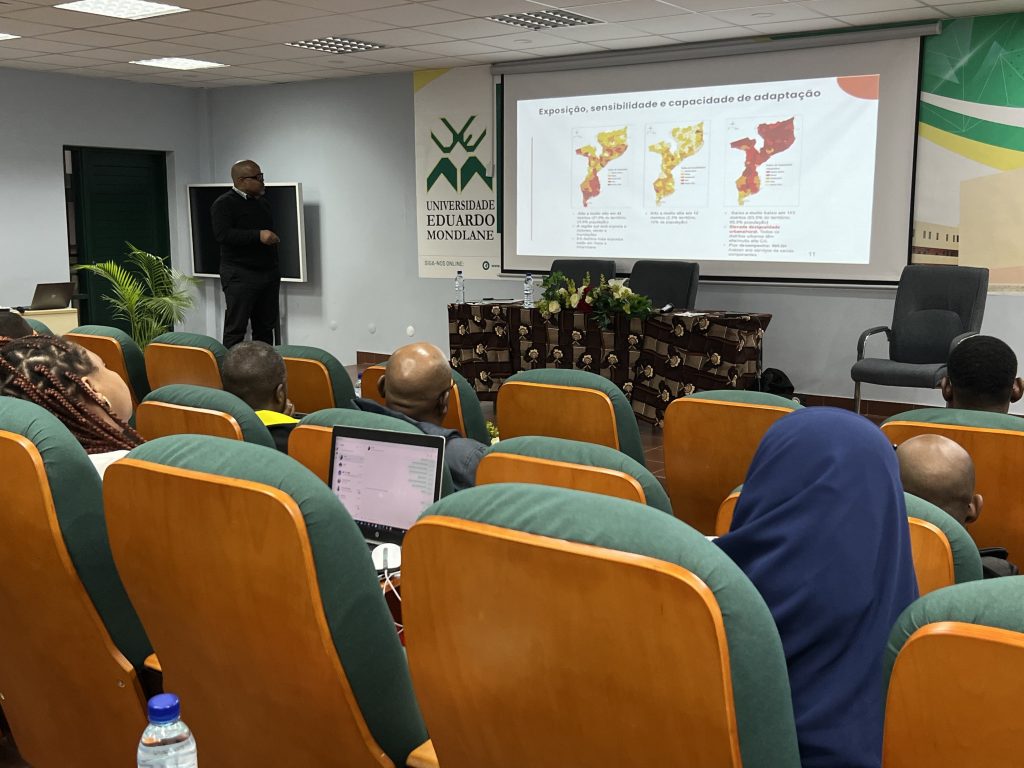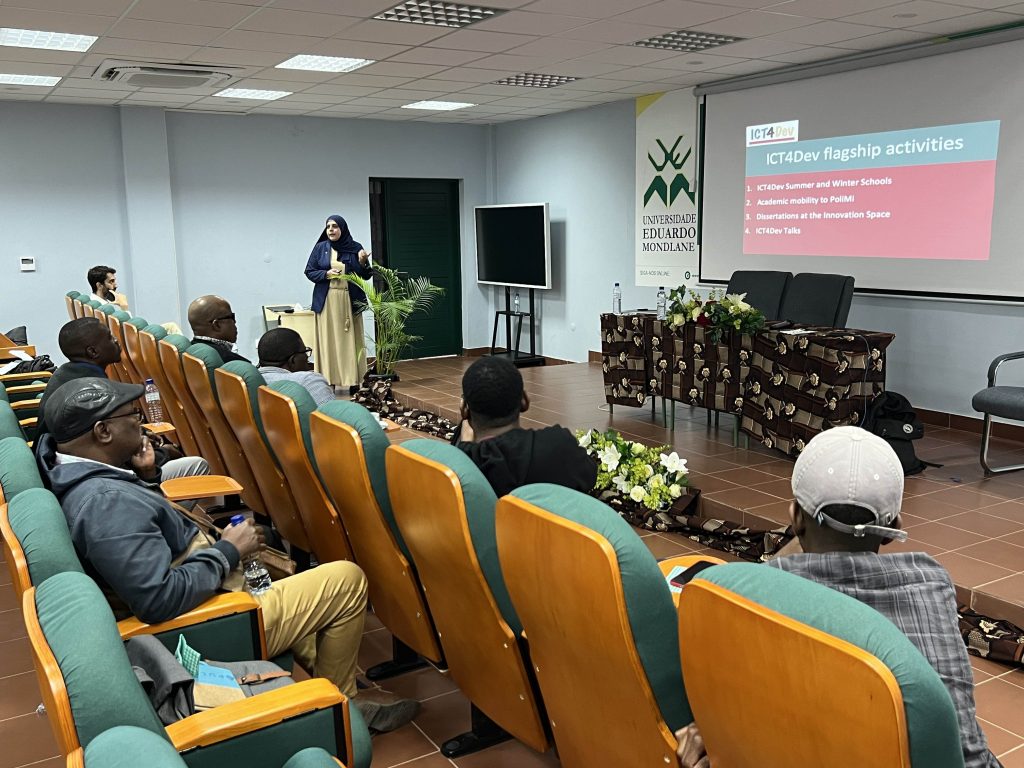Dr Andrea Ficchì and Dr Guido Ascenso co-organised and led a workshop and training at the Universidade Eduardo Mondlane (UEM, Maputo) from 30 September to 3 October 2024, hosted and supported by professors of UEM’s Faculties of Science and Engineering, Prof Genito Maure and Prof Dinis Juizo. This event was aimed at strenghtening existing technical capacities for climate services in Mozambique and support the engagement of researchers from Italy and Mozambique, including interactions with local stakeholders. Invited participants included UEM researchers, professors, and selected students, as well as representatives from national organisations involved in the climate services and disaster risk management value chain.
Andrea and Guido have been collaborating over the last few years at Politecnico di Milano (eiLab), bringing together their experience in hydro-meteorology and machine learning, while working for the PRINTFLOODS and CLINT projects, mainly on floods and cyclones. Both projects have case studies in Mozambique, with PRINTFLOODS focusing on coastal areas vulnerable to cyclones and coastal floods, while CLINT studies the Zambezi River Basin as one of its climate hotspot case studies. To drive positive local impacts in the region, the event at UEM aimed at boosting stakeholder engagement and capacity building efforts, to help the research meet the needs of end-users and contribute developing capacities on AI (coding).
The first part of the event was a 1-day workshop, entitled “Artificial Intelligence for Climate Services and Environmental Applications”, which brought together 25 participants from UEM and several local organisations, including CIUEM (Centro de Informática da Universidade Eduardo Mondlane), World Food Programme (WFP), Cruz Vermelha Mozambique (CVM), National Directorate of Water Resources Management (DNGRH), National Meteorological Institute of Mozambique (INAM) and Instituto Nacional de Governo Electrónico (INAGE).
The workshop kicked off with presentations of research carried out for PRINTFLOODS and CLINT at the eiLab, with in-person talks given by Dr Andrea Ficchì, Dr Guido Ascenso, and online presentations by Prof Andrea Castelletti and Lorenzo Scarpellini, on a range of topics: advancing flood and tropical cyclone forecasts, using AI for improving climate services with a focus on end-user needs, supporting adaptation solutions with more efficient and use-case driven models, and investigating the potential of satellite-based indexes for crop vulnerability assessment in Southern Africa.


The second half of the workshop started with an overview of recent and ongoing research at UEM, in the Faculties of Science and Engineering, with presentations by Prof Dinis Juizo, Prof Genito Maure, and Dr Roxan Cadir (UEM), and concluded with a presentation on flood and drought forecasting and monitoring activities in Mozambique by Dr Augustinho Vilanculos (DNGRH). UEM’s presentations focused on a wide range of recent studies related to the topics of AI for climate and environmental applications, as well as on the activities of another ongoing UEM/POLIMI collaborative project, called ICT4Dev, focused on developing digital skills and building partnerships, through trainings of students, teachers and researchers in the ICT sector across Mozambique.




The second part of the event was a 3-day traning, titled “Artificial Intelligence for Tropical Cyclones and Floods Resilience: From Theory, to Code, to Impact”, led by Andrea and Guido.
In the first day of the training, Andrea led an introduction to programming in Python, explaining the fundamentals needed to dive into the coding of the subsequent hands-on sessions. Participants were required to have only a basic level of programming, to allow all relevant practitioners and researchers to participate, removing a first technical barrier in the use of tools like AI. Knowing the basics of Python syntax and the most common constructs is indeed essential to work with big climate data and to setup AI algorithms, as Python has become the standard language in this field.
A first specific technical challege is often the preparation of the working environments with all the needed Python libraries. For this reason, a key preparatory task in the training was to provide participants with a guide for preparing such an environment (with conda) and helping them install everything needed on their laptops and local lab’s PCs.
In the afternoon, after the environments set-up, Andrea and Guido demonstrated how to download climate and hydrological data programmatically from the Copernicus Climate Data Store (CDS), via Python scripts. As an example, the participants were guided to download meteorological reanalysis data from ERA5 for an area covering Mozambique, but the methods presented can be applied to a wealth of datasets available on the CDS.
The second day of the training started with a theoretical presentation by Guido, covering the basic concepts of machine learning (from what it means for machines to learn, to the intuition behind stochastic gradient descent), ending with an overview of popular machine and deep learning architectures and of climate and hydrology topics and issues that machine learning is uniquely well-suited to address. In the aftenoon, Guido then led a hands-on session focused on the implementation of one of the pieces of research developed in the eiLab with Andrea: the bias adjustment and downscaling of tropical cyclone rainfall from ERA5. In this session, participants learned how to explore and pre-process ERA5 data, and how to write the code to create, train, and evaluate U-Net, a type of deep learning algorithm.

The third day of the training focused on AI appllications for advancing flood predictions. It started with a short serious game, to introduce in an interactive way the concepts of recurrent neural networks, a type of machine learning algorithms and the potential of AI to learn from patterns of historical data. Then, Andrea gave a theoretical introduction to the Long Short Term Memory (LSTM) model, explaining how it can be used to predict time series like river flows. After giving simple code examples to show the syntax used to build and run an LSTM model in Python, the participants were invited to explore a notebook developed to provide an example of how to forecast floods and how to post-process and adjust existing hydrological forecasts from state-of-the-art global models like GloFAS (part of the Copernicus Emergency Management Service), learning from previous observations or previous model errors.

Andrea and Guido were pleased with the enthusiastic participation of the 20 trainees, who represented a diverse group of key local stakeholders, alongside university professors, researchers, and students. Moreover, the training was highly interactive, fostering productive exchanges among all participants and creating new professional connections. In addition to knowledge exchange and networking, the event has laid the foundation for further collaborations between POLIMI, UEM, National Institutes and humanitarian organisations in Mozambique. This will contribute to the legacy and long-term impact of both the PRINTFLOODS and CLINT projects.


